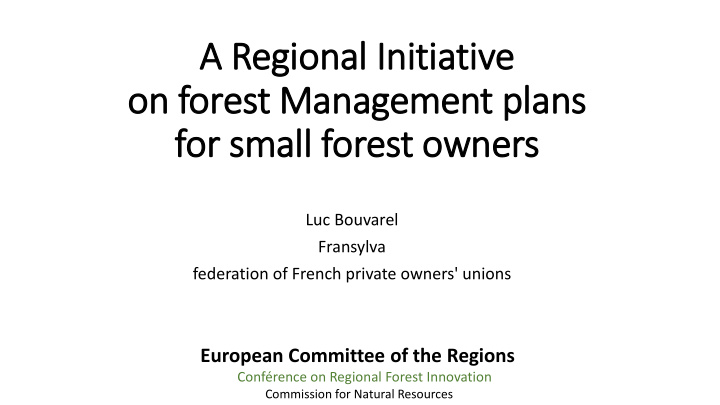



A A Regional In Initiative on forest Management pla lans for small forest owners Luc Bouvarel Fransylva federation of French private owners' unions European Committee of the Regions Conférence on Regional Forest Innovation Commission for Natural Resources
The contexte contexte • 96% of private forest owners are natural persons; they own 82% of the surface. • 85% of forest owners live in the area where their forest is located.
The context xte A majority of small properties: 3 million owners own less than 4 ha 445 000 owners own more than 4 hectares, or 77% of the private forest area. 189 000 owners own more than 10 hectares, or 63% of the private forest area. 69 000 owners own more than 25 hectares, or 47% of the private forest area. 11 000 owners own more than 100 hectares, or 23% of the private forest area.
The context xte First a heritage and a family activity 21% of forest owners think that the activity of the forest is economic with the obtaining of periodic income; 75% of private properties of more than 4 ha are affected by logging although only 34% of foresters testify to their interest the development of their heritage does not always include periodic income . 42% see it as a family activity and relaxation, 23% see it as a hunting territory, 23% live it as a passion and only 9% as a source of trouble.
Management documents development aid and forest protection • PSG 3M ha • CBPS 0,3M ha Owners endow their forest with • RTG 0,05M ha sustainable management documents (Simple Management Plan, Code of Good Forestry Practices, Model Management Regulations ...). Properties with PSG harvest more wood sustainably and reinvest more in the forest, especially in the case of production of lumber.
• Increase the number of properties covered by a A national project that plans silvicultural operations within approach a sustainable management framework deployed in consultation with the Regions • Improve the consideration of the forest in rural areas and territorial planning documents • Answer the questions of all the forest owners
Assessment of forest potential with economic support from the Regions and Europe • Territorial approach • Implementation of Forest Development Plans (PDM) • Qualification of forest stands at operational scales (1/25 000) for: stand types (environmental and social economic characteristics), the main species, the dimension of the trees, the improvement of the stands, their harvestability and their accessibility.
• Support for the realization of forest diagnostics leading to the implementation of a forecast of silvicultural operations and voluntary Propose an commitments in the certification of PEFC management. individual approach • Development of PSG between 10 and 25 ha and popularization of IBP (potential biodiversity index)
Go from the individual to the consultation between forest owners et au PSGc - Gathering all the owners managing their forest with an approved individual management document in one implies a coordination of the operations in the time and in the form - Propose to the other owners whatever the size of their property to join the approach
The Simple Plan of Concerted Management : • This new device allows in time to associate all owners regardless of the surface of the property, each keeping his freedom to act. • It brings individual benefits to the economy of management because involves each intervention larger volumes or surfaces and thus makes it easier to mobilize companies with negotiated conditions, which allows for sometimes difficult operations to do economically by being alone.
But also and importantly • This approach also has the advantage of being voluntary and validated which gives it weight and leads to an almost obligatory recognition by switching from an individual mode of operation to one that represents several people and therefore bears the interest of a group almost similar to the general interest of the forest and active foresters. • It can promote access to current or future sources of financing such as those related to carbon sequestration, tomorrow to the preservation of drinking water, • It allows a local dynamic between the owners but also by the induced activity favors the maintenance to see the creation of jobs upstream of the sector essential for the realization of the operations of management.
To conclude • Approach linking the individual freedom of management to territorial coherence • Improves and reinforces the multifunctional management of Approach linking the individual freedom of management to territorial coherence, • Improve and strengthen the multifunctional management of the forest ecosystem, • Brings greater recognition of the action of the owners, • Facilitates the realization of operations, • Favorable to the creation of jobs in rural environment, • Shows in time a growing adherence of owners locally.
Recommend
More recommend